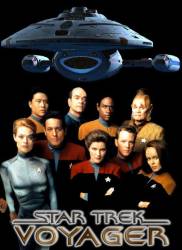Factual error: The event horizon of a quantum singularity (aka black hole) is not a physical barrier you can punch a hole through but a theoretical one, which can't be escaped from without faster then light travel.
Emanations - S1-E9
Factual error: To protect the warp core, Janeway instructs Paris to move away from the rings at Warp 7. Moments later (Janeway, Torres and Tuvok are still in the same position), Paris tells Janeway they are 0.6 light years away from the rings. Warp 7 is 656 times the speed of light. It would take about 8 hours to travel 0.6 light years at Warp 7.
Suggested correction: The warp scale, especially since it's fictional, has never been precisely defined.
While it's never been defined, certain aspects of warp speed drive and the length of a light year are accepted. Even if Warp 7 is double what is suggested in the mistake, it would still be 4 hours. The scene in question shows no lengthy travel at Warp 7.
The Voyager Conspiracy - S6-E9
Factual error: When the alien contacts Voyager after his catapult jump, he states that he is 5,000 light years away. Despite the distance, he and Janeway have a real time conversation. With this incredible communications technology, Voyager (which is at this point less than 55,000 light years from the Alpha Quadrant) should be able to have several back and forth conversations a day with Starfleet.
Factual error: Chakotay says "if our orbit starts to decay, Voyager will begin to feel the effects of the differential, and we'll begin aging hundreds of times faster than we would in normal space". Whilst it is true that they would be aging faster relative to normal space, they would not instantly become old. Time would simply slow around them, so whilst they would be aging faster relative to normal space, they would not all of a sudden become really old - which is how it is made out to be. They would all age the same amount whether in a standard orbit or in a more decayed orbit. (00:06:37)
Suggested correction: There is nothing incorrect about what he said. They will start ageing hundreds of times faster than in normal space.
Aging implies getting/feeling older. They'd only be "aging" relative to normal space. What would happen would be more akin to time travel, with the universe getting older around them.
But the point is, they wouldn't age faster just because "normal" time slows down. If they spent a year on the planet, they'd age 1 year, not 100 years.





